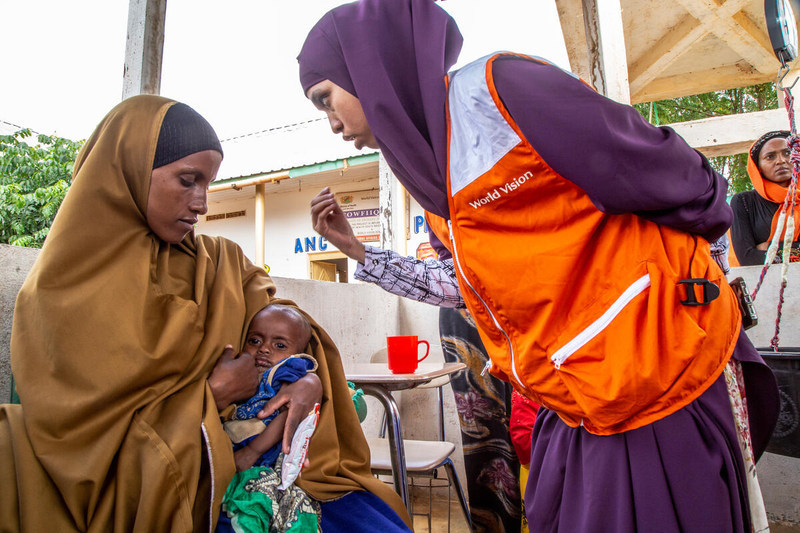Globally, 345 million children and families are acutely hungry and struggling to get enough to eat. Hunger is widespread across multiple regions, with children living in conflict zones twice as likely to be malnourished

World-Vision-frontline-staff/Credit: Global
A new report from global humanitarian organization World Vision highlights how spiraling food prices are contributing to the global hunger crisis and putting the world’s most vulnerable children at increased risk of death.
- In Sudan, food prices have gone up 143% since 2021[1], a year after the FAO’s global food price index saw its highest ever annual increase
- It would take two weeks for a Somalian to earn enough to buy a common basket of food items[2], compared to just 1.2 hours for an American
- An estimated 45 million children under 5 are so thin for their height, they’re at increased risk of death [3]
“Food prices have increased globally over the past few years as the world grapples with the triple crisis of COVID-19, conflict, and climate change,” said Mary Njeri, World Vision’s Global Hunger Response Director. “Most people around the globe are experiencing the impact of increasing food prices, but for some, they have potentially deadly consequences – almost 50 million children are now so thin for their height that they’re at heightened risk of death. The numbers of acutely hungry people have already gone up by 25% since the beginning of the year, and unless we take urgent action, more families will struggle to feed themselves, too.”
World Vision’s research found that there had been an overall increase of 14% in food prices in the past year. Rises have been especially sharp in some of the poorest countries, especially those reliant on imports or affected by climate change. For example, while there has been a 9% increase here in the U.S. in the past year, food prices have increased by 33% in Angola, 42% in Ethiopia, and 143% in Sudan since 2021. In the Solomon Islands, rice and dairy prices have tripled since 2021.
Globally, 345 million children and families are acutely hungry and struggling to get enough to eat. Hunger is widespread across multiple regions, with children living in conflict zones twice as likely to be malnourished.
The crisis is particularly grave in Somalia, where more than 7 million people (half the population) are grappling with hunger and parts of the country are at imminent risk of famine. The worst drought in 40 years has killed livestock – a critical income source for families – and rising food prices worsened by the war in Ukraine have left millions one step away from starvation.
The cost of a basic shopping basket for an average worker helps to illustrate the disparity. For example, World Vision’s report found that in Somalia it would take a worker two weeks (13.7 days) to earn enough money to buy the same basic food supplies that an American could earn in a little over an hour.
“This is completely unattainable for the average family and shows just how important it is to both tackle the root of these crises – political will to end conflicts and fight climate change – and provide the life-saving aid children and families need to survive in the immediate term,” Njeri said.
“We always say ‘never again,’ but families are currently on the edge in a devastating crisis, and make no mistake, unless we act, children will die of hunger,” she added. “There is enough money and food in the world. No child should be going hungry in the 21st century. We must act now.”
In response to the global hunger crisis, World Vision has launched the largest humanitarian undertaking in its more than 70-year history, aiming to deliver life-saving aid to 22 million people in 25 countries where hunger is at its worst. World Vision is the largest distribution partner of the U.N.’s World Food Programme, last year reaching more than 16 million of the most vulnerable people with life-saving food security and nutrition programs.
About World Vision :
World Vision is a Christian humanitarian organization dedicated to working with children, families and their communities worldwide to reach their full potential by tackling the causes of poverty and injustice. With staff in nearly 100 countries, World Vision serves all people, regardless of religion, race, ethnicity, or gender. For more information, please visit www.WorldVision.org/media-center/ or on Twitter @WorldVisionUSA.
Source: Company Press Release
